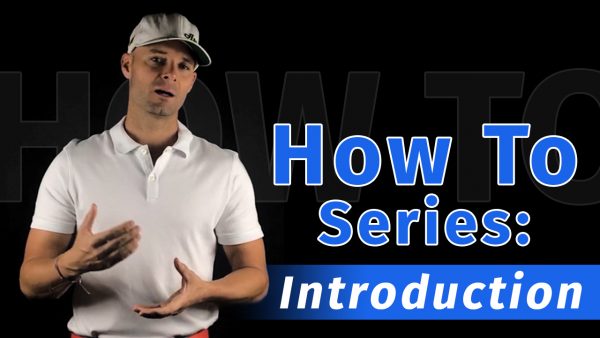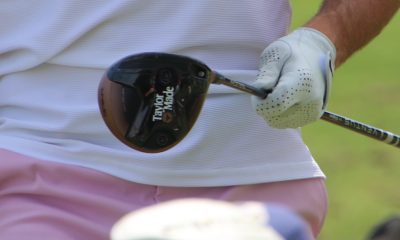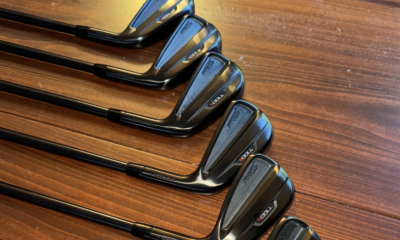How-to Series: How to move your hips on the backswing
This is the first installment in our How To Series — follow this plan to master the movements of the hips on the backswing!

Watch the series introduction here
This new series is all about helping you improve your golf swing quickly. We’re going to break the swing down into its component parts and give you specific practice direction — master these key elements of the swing and you’ll see improvement fast!
- LIKE25
- LEGIT8
- WOW1
- LOL0
- IDHT0
- FLOP15
- OB12
- SHANK46
Instruction
The Wedge Guy: The easiest-to-learn golf basic

My golf learning began with this simple fact – if you don’t have a fundamentally sound hold on the golf club, it is practically impossible for your body to execute a fundamentally sound golf swing. I’m still a big believer that the golf swing is much easier to execute if you begin with the proper hold on the club.
As you might imagine, I come into contact with hundreds of golfers of all skill levels. And it is very rare to see a good player with a bad hold on the golf club. There are some exceptions, for sure, but they are very few and very far between, and they typically have beat so many balls with their poor grip that they’ve found a way to work around it.
The reality of biophysics is that the body moves only in certain ways – and the particulars of the way you hold the golf club can totally prevent a sound swing motion that allows the club to release properly through the impact zone. The wonderful thing is that anyone can learn how to put a fundamentally sound hold on the golf club, and you can practice it anywhere your hands are not otherwise engaged, like watching TV or just sitting and relaxing.
Whether you prefer an overlap, interlock or full-finger (not baseball!) grip on the club, the same fundamentals apply. Here are the major grip faults I see most often, in the order of the frequency:
Mis-aligned hands
By this I mean that the palms of the two hands are not parallel to each other. Too many golfers have a weak left hand and strong right, or vice versa. The easiest way to learn how to hold the club with your palms aligned properly is to grip a plain wooden ruler or yardstick. It forces the hands to align properly and shows you how that feels. If you grip and re-grip a yardstick several times, then grip a club, you’ll see that the learning curve is almost immediate.
The position of the grip in the upper/left hand
I also observe many golfers who have the butt of the grip too far into the heel pad of the upper hand (the left hand for right-handed players). It’s amazing how much easier it is to release the club through the ball if even 1/4-1/2″ of the butt is beyond the left heel pad. Try this yourself to see what I mean. Swing the club freely with just your left hand and notice the difference in its release from when you hold it at the end of the grip, versus gripping down even a half inch.
To help you really understand how this works, go to the range and hit shots with your five-iron gripped down a full inch to make the club the same length as your seven-iron. You will probably see an amazing shot shape difference, and likely not see as much distance loss as you would expect.
Too much lower (right) hand on the club
It seems like almost all golfers of 8-10 handicap or higher have the club too far into the palm of the lower hand, because that feels “good” if you are trying to control the path of the clubhead to the ball. But the golf swing is not an effort to hit at the ball – it is a swing of the club. The proper hold on the club has the grip underneath the pad at the base of the fingers. This will likely feel “weak” to you — like you cannot control the club like that. EXACTLY. You should not be trying to control the club with your lower/master hand.
Gripping too tightly
Nearly all golfers hold the club too tightly, which tenses up the forearms and prevents a proper release of the club through impact. In order for the club to move back and through properly, you must feel that the club is controlled by the last three fingers of the upper hand, and the middle two fingers of the lower hand. If you engage your thumbs and forefingers in “holding” the club, the result will almost always be a grip that is too tight. Try this for yourself. Hold the club in your upper hand only, and squeeze firmly with just the last three fingers, with the forefinger and thumb off the club entirely. You have good control, but your forearms are not tense. Then begin to squeeze down with your thumb and forefinger and observe the tensing of the entire forearm. This is the way we are made, so the key to preventing tenseness in the arms is to hold the club very lightly with the “pinchers” — the thumbs and forefingers.
So, those are what I believe are the four fundamentals of a good grip. Anyone can learn them in their home or office very quickly. There is no easier way to improve your ball striking consistency and add distance than giving more attention to the way you hold the golf club.
More from the Wedge Guy
- The Wedge Guy: Golf mastery begins with your wedge game
- The Wedge Guy: Why golf is 20 times harder than brain surgery
- The Wedge Guy: Musings on the golf ball rollback
- LIKE85
- LEGIT13
- WOW6
- LOL1
- IDHT0
- FLOP4
- OB1
- SHANK8
Instruction
Clement: Stop ripping off your swing with this drill!

Not the dreaded headcover under the armpit drill! As if your body is defective and can’t function by itself! Have you seen how incredible the human machine is with all the incredible feats of agility all kinds of athletes are accomplishing? You think your body is so defective (the good Lord is laughing his head off at you) that it needs a headcover tucked under the armpit so you can swing like T-Rex?
- LIKE0
- LEGIT2
- WOW2
- LOL0
- IDHT0
- FLOP0
- OB0
- SHANK2
Instruction
How a towel can fix your golf swing

This is a classic drill that has been used for decades. However, the world of marketed training aids has grown so much during that time that this simple practice has been virtually forgotten. Because why teach people how to play golf using everyday items when you can create and sell a product that reinforces the same thing? Nevertheless, I am here to give you helpful advice without running to the nearest Edwin Watts or adding something to your Amazon cart.
For the “scoring clubs,” having a solid connection between the arms and body during the swing, especially through impact, is paramount to creating long-lasting consistency. And keeping that connection throughout the swing helps rotate the shoulders more to generate more power to help you hit it farther. So, how does this drill work, and what will your game benefit from it? Well, let’s get into it.
Setup
You can use this for basic chip shots up to complete swings. I use this with every club in my bag, up to a 9 or 8-iron. It’s natural to create incrementally more separation between the arms and body as you progress up the set. So doing this with a high iron or a wood is not recommended.
While you set up to hit a ball, simply tuck the towel underneath both armpits. The length of the towel will determine how tight it will be across your chest but don’t make it so loose that it gets in the way of your vision. After both sides are tucked, make some focused swings, keeping both arms firmly connected to the body during the backswing and follow through. (Note: It’s normal to lose connection on your lead arm during your finishing pose.) When you’re ready, put a ball in the way of those swings and get to work.

Get a Better Shoulder Turn
Many of us struggle to have proper shoulder rotation in our golf swing, especially during long layoffs. Making a swing that is all arms and no shoulders is a surefire way to have less control with wedges and less distance with full swings. Notice how I can get in a similar-looking position in both 60° wedge photos. However, one is weak and uncontrollable, while the other is strong and connected. One allows me to use my larger muscles to create my swing, and one doesn’t. The follow-through is another critical point where having a good connection, as well as solid shoulder rotation, is a must. This drill is great for those who tend to have a “chicken wing” form in their lead arm, which happens when it becomes separated from the body through impact.
In full swings, getting your shoulders to rotate in your golf swing is a great way to reinforce proper weight distribution. If your swing is all arms, it’s much harder to get your weight to naturally shift to the inside part of your trail foot in the backswing. Sure, you could make the mistake of “sliding” to get weight on your back foot, but that doesn’t fix the issue. You must turn into your trial leg to generate power. Additionally, look at the difference in separation between my hands and my head in the 8-iron examples. The green picture has more separation and has my hands lower. This will help me lessen my angle of attack and make it easier to hit the inside part of the golf ball, rather than the over-the-top move that the other picture produces.


Stay Better Connected in the Backswing
When you don’t keep everything in your upper body working as one, getting to a good spot at the top of your swing is very hard to do. It would take impeccable timing along with great hand-eye coordination to hit quality shots with any sort of regularity if the arms are working separately from the body.
Notice in the red pictures of both my 60-degree wedge and 8-iron how high my hands are and the fact you can clearly see my shoulder through the gap in my arms. That has happened because the right arm, just above my elbow, has become totally disconnected from my body. That separation causes me to lift my hands as well as lose some of the extension in my left arm. This has been corrected in the green pictures by using this drill to reinforce that connection. It will also make you focus on keeping the lead arm close to your body as well. Because the moment either one loses that relationship, the towel falls.


Conclusion
I have been diligent this year in finding a few drills that target some of the issues that plague my golf game; either by simply forgetting fundamental things or by coming to terms with the faults that have bitten me my whole career. I have found that having a few drills to fall back on to reinforce certain feelings helps me find my game a little easier, and the “towel drill” is most definitely one of them.
- LIKE12
- LEGIT2
- WOW2
- LOL0
- IDHT0
- FLOP2
- OB0
- SHANK8
-

 19th Hole1 week ago
19th Hole1 week agoDave Portnoy places monstrous outright bet for the 2024 Masters
-

 19th Hole2 weeks ago
19th Hole2 weeks agoThings got heated at the Houston Open between Tony Finau and Alejandro Tosti. Here’s why
-

 19th Hole1 week ago
19th Hole1 week agoTiger Woods arrives at 2024 Masters equipped with a putter that may surprise you
-

 19th Hole2 weeks ago
19th Hole2 weeks agoReport: Tiger Woods has ‘eliminated sex’ in preparation for the 2024 Masters
-

 19th Hole3 days ago
19th Hole3 days agoTwo star names reportedly blanked Jon Rahm all week at the Masters
-

 19th Hole3 days ago
19th Hole3 days agoNeal Shipley presser ends in awkward fashion after reporter claims Tiger handed him note on 8th fairway
-

 19th Hole2 weeks ago
19th Hole2 weeks agoAddiction, spinal fusion, and scam artists – Everything Anthony Kim revealed in candid interview with David Feherty
-

 19th Hole2 weeks ago
19th Hole2 weeks agoAnthony Kim says doctors told him that he ‘may not have much time left’ ahead of LIV return























Ron Burgundy
Jan 26, 2020 at 12:59 am
Had anyone bought this? Is it any good?
geohogan
Dec 23, 2018 at 9:47 pm
@raybennett, if only it were true.
Bobby Jones turned his torso (from hips to sternum turning together), using his feet and knees. There is no sway to the right.
This video describes left hip moving closer to the ball. ie not a turn of the torso
but a slide of hips back toward the right, which can only happen when shoulders tilt , left shoulder down. Its the False backswing made popular with the one plane swing, that ended the career of Mike Weir and others.
Its easily proven. Stand straight and tilt the left shoulder down toward the ball. Note how right hip moves(sways to the right) and pelvis slides= FALSE BS TURN
Compare that to standing straight and turning to shake hands with someone to your right, with your left hand. Rather than right hip moving laterally to the right, it moves toward the left.
Kenny
Dec 21, 2018 at 11:29 pm
Trying to link movements of body parts together to try and make a swing is absurd.
Don Toth
Dec 18, 2018 at 8:40 pm
Really like Session 1 it’s a clear and simple plan for a start. Many students can get so far off track early in the swing motion. This give them a very clear plan to feel and execute right at the start of the movement.
Very Nice!!
Golf
Dec 18, 2018 at 8:18 am
I typically like Lucas but this is rubbish. Keep it simple and focus more on impact not the takeaway like Adam Young does. Better results, faster and simpler.
geohogan
Dec 17, 2018 at 11:17 pm
x Factor might be valid if shoulder joints were simply blobs on the top end of the spine.
The function of the scapula and clavicle allow a very free range of movement about the top of the torso.
That range of motion has lead some to think that X factor means restricting hip turn… they would be wrong, leading to spine issues for countless golfers.
Ray Bennett
Dec 17, 2018 at 4:48 pm
Spot on advice. This is exactly what Bobby Jones did to start his backswing which he described in his publication Bobby Jones on Golf. It is great to see the old school instruction returning to the game.
smz
Dec 17, 2018 at 5:50 pm
… but it only applies to swings with a whippy hickory shafted club…!
geo
Dec 17, 2018 at 9:14 pm
http://www.golfwrx.com/forums/topic/553341-hickory-golf-clubs-shafts/
“hickory shafts generally run at stiffer frequencies than the steel shafts of the same
“flex”. Bobby Jones hickory shafts would rate X flex with very low torque, by todays
definition “
geohogan
Dec 23, 2018 at 12:32 pm
@raybennett, if only it were true.
Bobby Jones turned his torso (from hips to sternum turning together), using his feet and knees. There is no sway to the right.
This video describes left hip moving closer to the ball. ie not a turn of the torso
but a slide of hips back toward the right, which can only happen when shoulders tilt , left shoulder down. Its the False backswing made popular with the one plane swing, that ended the career of Mike Weir and others.
Its easily proven. Stand straight and tilt the left shoulder down toward the ball. Note how right hip moves(sways to the right) and pelvis slides= FALSE BS TURN
Compare that to standing straight and turning to shake hands with someone to your right, with your left hand. Rather than right hip moving laterally to the right, it moves toward the left.
Raymond CHASTEL
Dec 17, 2018 at 12:42 pm
Dear Mr Wald ,Nice and thorough presentation ,but I beg to differ:my right instep is firmly dug in the turf:then I start by pushing my left shoulder forward :I don’t move back as you show:my hips stay as straight as possible while the shoulders turn fully ,to create the differential HIPS-SHOULDERS (The X Factor ).The purpose is to coil the core to provide the maximum spring effect giving power.
I’m 84 ,average build,5fet 9 ,160 pounds ,I play three /four times a week to a 7 Handicap on the FRENCH RIVERA ,all year round ,no winter,no winter greens over here
gaspard
Dec 17, 2018 at 5:48 pm
… and you drink beaujolais spritzers on your fremch golf course for nourishment and to combat thirst…. 😮
Wyatt
Dec 17, 2018 at 12:07 pm
Too many moving parts for me. When I take my setup, I make sure my left hip is slightly elevated and then I make my normal inside to out swing. The hips make a normal turn when doing that.
Gary Slatter PGA
Dec 17, 2018 at 12:02 pm
1 and 2 were OK, I disagree with consciously turning your hips. They turn in response to your knees and shoulder turn, in my opinion.
smz
Dec 17, 2018 at 5:52 pm
…. and for some it’s the m a s s of the a s s according to Snead with his backswing squat that he carries into his downswing…..!
Jim
Dec 18, 2018 at 10:05 pm
No, turning shoulder pulls your ribs & torso. Does NOT necessarily make the hip turn. Bigger muscular golfers must make a coordinated hip turn to achieve the most they can get – and thin flexible people can get 100° of turn and not even notice they barely turned 25 degrees with their hips.
MDH
Dec 17, 2018 at 11:29 am
I think you should demonstrate the hip turn showing it from the front and back view.
smz
Dec 16, 2018 at 1:40 pm
WARNING: If your pot belly covers your belt buckle do not, I repeat, do not rotate your hips because that will twist your spine and your hanging pot belly will overstress your spine and cause lower back pain. Even a smaller protruding gut will hurt your spine sfter too many practice swings. You have been warned.
geohogan
Dec 17, 2018 at 9:09 am
HIps dont rotate. The knees move the hips.
Prove it to yourself by tying a belt around your thighs above the knees so knees cant move.
Now try turning your hips.
Golf instruction that doesnt involve the knees leading the hips, is advocating shoulder tilt and hip slide…. a fake turn.
smz
Dec 17, 2018 at 5:45 pm
Okay, matey…. it’s the legs first that move the hips in a rotatory motion. Happy?
geohogan
Dec 17, 2018 at 8:44 pm
@smz, the legs move the torso. Hips happen to go along for the ride.
Gary “The Swings the Thing” Slatter PGA knows.
smz
Dec 17, 2018 at 10:38 pm
torso –the trunk of the human body without, or considered independently of, the head and limbs.
Hips are part of the torso… and the semi-flexible core separates the shoulders from the hips… called the X-Factor.
geohogan
Dec 17, 2018 at 11:14 pm
x Factor might be valid if shoulder joints were simply blobs on the top end of the spine.
The function of the scapula and clavicle allow a very free range of movement about the top of the torso.
That range of motion has lead some to think that X factor means restricting hip turn… they would be wrong, leading to spine issues for countless golfers.
Kenny
Dec 21, 2018 at 11:35 pm
X factor is nonsense.
geohogan
Dec 18, 2018 at 3:14 pm
http://www.oandplibrary.org/reference/uclamanual/UCLA-02.pdf
When we use the full range of motion of the scapula and shoulder joint
combined with turning of the torso 40-50 degrees, the so called X factor is easily
achieved with sternum consistently aligned with the sagittal plane.
ie little or no twisting of the spine.
geo
Dec 18, 2018 at 3:37 pm
http://www.oandplibrary.org/reference/uclamanual/UCLA-02.pdf
The torso can be turned 40=50 degrees by the legs, knees and feet.
The balance of BS, can be made by the shoulder joint and scapula without twisting the spine.
ref. ROM above
If the so called X factor is achieved by turning the upper torso more than the lower torso, injury to the spine will result.
Kenny
Dec 21, 2018 at 11:33 pm
Correct in that the hips don’t rotate independently, but the knees don’t move the hips. All motion stems from the feet. Sequence of motion in the joints is feet, ankles, knees, pelvis.
geohogan
Dec 23, 2018 at 12:16 pm
@kenny, agree totally, the hips dont rotate independently.(Hips have no means to move independently of lower limbs.)
Suggest that sequence is feet, ankles, knees, torso(hips are moved with the torso).
Once we understand this simply basic of human physiology, we must understand how foolish it is to think that we can possibly , “fire the hips”.
Bert Gwaltney
Dec 15, 2018 at 9:25 am
OK, found the first segment. Thanks
Bert Gwaltney
Dec 15, 2018 at 9:16 am
Introductions are OK, but should have included the first segment. I lost interest quickly.